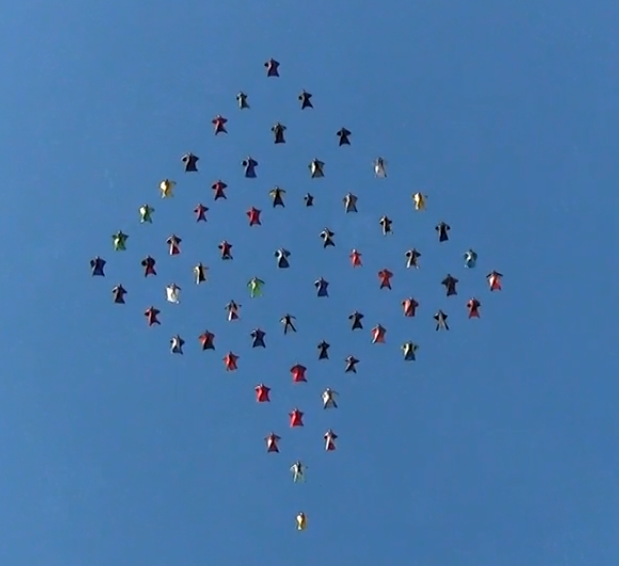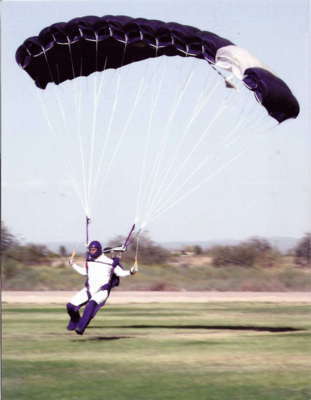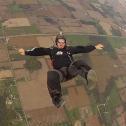Recommended Posts
I can't count the number of times I've been on bigger ways and people have looked at my jump numbers (back in the day anyhow) and said, you shouldn't be here. Truth be told, I've only screwed the pooch on bigger ways once or twice in my life whereas people with more jump numbers seem to screw the pooch more than I.
Anyone and everyone has gone low. Ain't no thang in my book and I'd jump with you again reagardless. I'm out at the DZ for the comraderaie not the contest to be cool.
-- (N.DG) "If all else fails – at least try and look under control." --
Please keep the thread on topic and - rwieder and brits 17 - take the one-on-one exchanges to PMs.
John
billvon 2,995
Second jump of the 300 way, I went low. Shit, I thought, I gotta fix this! So I built some swoop cords and got a T-shirt. With that much extra drag I figured I was fine.
Fifth jump or so I went low again. The drill on the 300-way was to try to get back for 10 seconds, then turn and track. So I gave it my best shot for 10 seconds, then started tracking - from 18,000 feet. I had plenty of time to punish myself as I tracked something like 3 miles.
I opened and landed near the highway. Someone landed near me so I walked over to him. And who was it but Dan BC, one of the organizers and the last person I wanted to see.
"Why'd you land way out here?" he asked.
"I, uh, went low."
"Really?" he said. "So did I. Man that base is slow."
Well, after that there was no way I was going low again. So I borrowed an XXL sweatshirt and floppy shorts (which was nice since I was freezing anyway) and finally managed to slow down to the base's consistent 108-110 mph speed. Carey Peck had webbed gloves, massive swoop cords, booties and a sweatshirt. I think he would have used a drouge if they would have allowed it. But in the end we all adapted and got the record.
billvon 2,995
Depends on the dive. In most bigways the rule is "stay until breakoff then leave with the group." This helps prevent showing up unexpected in the group that exits after you. Sometimes, on bigger dives where you take up the entire plane (or more than one plane) it can be advantageous to leave earlier - BUT this has to be discussed with the organizer beforehand.
I generally discourage barrel rolls on my dives. If you are low, track as long as humanly possible (to 2000 feet) check quickly, wave off and pull. The time you spend barrel rolling is time you _could_ be spending tracking, and very very few people are good enough to keep a max track while barrel rolling. You are better off getting clear of people than seeing that you're not going to get clear of someone.
mark987 0
as for going low i've never seen you dump below 9'000ft!!!!!!!!!!!!!!!!!!!!!!!!!!!!!!!!!
see you in the pub sunday.because it won't be the d.z
Considering that is the hard deck for many of us.
I've pulled at 2.5k for larger jumps, and cant say that i'm much a fan of that either (open canopy at 1.6k on one of them, 1.8 on the other two) , pulling at 2k would have put me at almost 1000 feet open canopy , wow...
As far as going low in the formation, shit, follow the plan. Simple. If you are low, your buddies on the dive with you should hopefully realize that you are not there, and I know that when I realize someone has gone low, I keep track of where they are, and I watch for where they track (since they will track before the me / rest of us) ... It's not hard to see people below you when tracking, dont get on top of anyone, and check your airspace before opening, guess I'm not seeing the difficulty of this concept.
FGF #???
I miss the sky...
There are 10 types of people in the world... those who understand binary and those who don't.
rwieder 0
QuoteCant say that I'm a big fan of telling a "newer" jumper to be pulling at 2k feet
Yet another reply to a post that is not addressing the topic. Unnecessary inflammatory comment removed by slotperfect you'll notice i said that's what i would do, not what everyone else should do.
I never told anyone where to deploy, just where i would.
"You're Holding The Rope And I'm Taking The Fall"
QuoteQuoteCant say that I'm a big fan of telling a "newer" jumper to be pulling at 2k feet
Yet another reply to a post that is not addressing the topic. Unless your just plain daft, (which you may be for all i know) you'll notice i said that's what i would do, not what everyone else should do.
I never told anyone where to deploy, just where i would.
You said that's what you would do, however Bill said:
QuoteIf you are low, track as long as humanly possible (to 2000 feet) check quickly, wave off and pull.
And I personally dont think that this is good "blanket" advice. Clearly if you are on a huge jump that you already planned on pulling low, 2000ft can be safe, but I wouldnt recomend that for a normal jump. Especially if you get to 2k, then wave off, then pull, your now getting damn close to cypress altitudes..
FGF #???
I miss the sky...
There are 10 types of people in the world... those who understand binary and those who don't.
Two advantages - most people in the formation will know where you are (even though you are low), and when they see you leave (you will reach breakoff a wee bit before they do) they will know where you went. Everybody then gets their own piece of sky to deploy in.
Good question!
John
billvon 2,995
Nor am I. However, if you end up very low on the breakoff, you have to take it as low as possible to get as much separation as possible. This is an excellent reason to NOT do bigways until you are very good at:
-tracking
-fall rate control
-breakoff awareness
Use your good judgement on the ground so you do not have to discover if you have good reactions at 2000 feet.
>pulling at 2k would have put me at almost 1000 feet open canopy , wow...
If you have a canopy that really snivels for 900 feet - for god's sakes, fix your gear! If a canopy will not save your life if deployed near 1000 feet, or will cause a two-out if deployed at 1800 feet with a cypres installed, it is not a very good lifesaving device.
Or make special arrangements to take into account the limitations of your equipment (like not doing bigways, and always opening high.)
>It's not hard to see people below you when tracking. . .
Definitely true.
>dont get on top of anyone . . .
It can be very difficult to determine if someone who is 500 feet below you and 20 feet out is clear of you. And if they are just in front of you - what do you do? Track over them and hope they don't pull right then? Turn left or right and avoid the other jumpers on the bigway? Stop, pull before you get to him and hope you clear the camera flyer? Those are all decisions best made before one finds oneself in the situation.
>and check your airspace before opening, guess I'm not seeing the difficulty of this concept.
It's not hard on a 6-way. It's considerably harder with a 40-way with two cameramen above you, two guys low, and four guys whose idea of a track is to dive straight down.
Remster 30
As Bill and John mentioned, there are 2 basic theories if you go and stay low:her stay with the group and fight to get back up until planned breakoff, and leave with the group. OR, fight it until you make the decision taht you will not make it back at all and its a lost cause, and then track away.
I prefer the 1st option and thats the one I default to if nothing else is discussed.
But if you end up 400 feet too low on a 6 way where you exited together, there is more at play then just a slight fall rate difference. I'd get a much bigger jumpsuit, find a different group, or get all of them to wear lead
kallend 2,027
Quote
But if you end up 400 feet too low on a 6 way where you exited together, there is more at play then just a slight fall rate difference. I'd get a much bigger jumpsuit, find a different group, or get all of them to wear lead.
Or get better at estimating distance. If anyone really gets 400ft low on a 6-way then he or she has some really serious problems to deal with.
The only sure way to survive a canopy collision is not to have one.
stefd 0
Blue skies Stefd
Quote...
As Bill and John mentioned, there are 2 basic theories if you go and stay low:her stay with the group and fight to get back up until planned breakoff, and leave with the group. OR, fight it until you make the decision taht you will not make it back at all and its a lost cause, and then track away.
...
Funny how different DZs promote one option over the other.
If I'm fairly low, I like option 2 best because I don't know that the others in the formation will see me and if they don't then they might be tracking faster than me and going right over the top of me and that would be bad - hopefully during my barrel roll I would be able to spot them...the second I know that I'm not going to get back up, I want to track as fast and as far way (perpendicular to jump run) as I possibly can and wave/pull at 2-2.5kft.
If I'm close enough that I'm very sure that they should be able to see me at breakoff, then my thought is to wait until they break and then pick a vacant sector to use for tracking away. Maybe even take the center after it's cleared if it's open with no camera.
Help me here...
flamers, give me a break...never too old to learn.
I think we're all Bozos on this bus.
Falcon5232, SCS8170, SCSA353, POPS9398, DS239
riggerrob 643
Hee!
Hee!
I have seen several junior jumpers chastized for using Plan B.
L.O. 0
AFB, charter member.
What was not mentioned in this thread is the importance of FLAT tracking.
Edited to add:
I resurrected this post because of the discussion going on in the Incidents forum about the Titusville collision. There was a lot of banter about what to do if you went low and there was a reference to this thread.
I think we're all Bozos on this bus.
Falcon5232, SCS8170, SCSA353, POPS9398, DS239
Legs 0
Quite typical. Yet, there is some interesting opinions stated here. The OP in the other thread probably did not search for existing threads on this topic.
I think we're all Bozos on this bus.
Falcon5232, SCS8170, SCSA353, POPS9398, DS239
If you are doing some relatively small RW (2-10 way) and you lose a jumper who dropped low on the formation, does everyone not go to the low man ?? I thought its easier for all the jumpers to recognize that one jumper is low and get to that person and build the formation again, since it is MUCH easier to drop than it is to rise. At least thats what I've learned about smaller fun jump RW .....




.thumb.jpg.4bb795e2eaf21b8b300039a5e1ec7f92.jpg)




People who get paranoid about going low tend to end up floaty. That is just as bad.
The only sure way to survive a canopy collision is not to have one.
Share this post
Link to post
Share on other sites